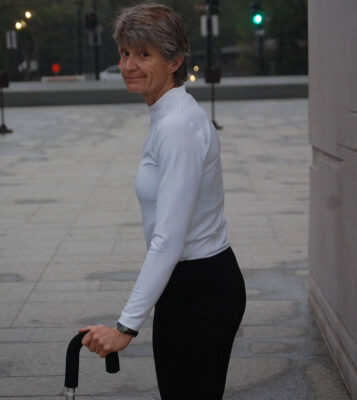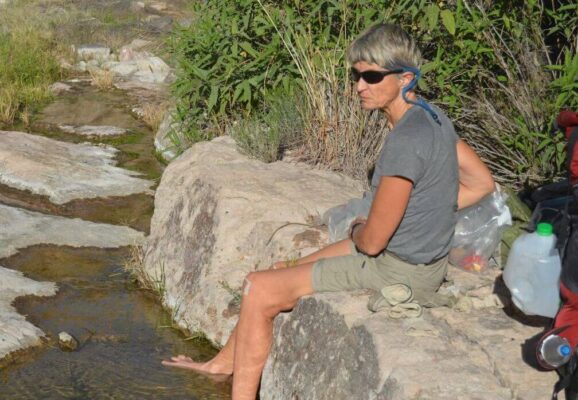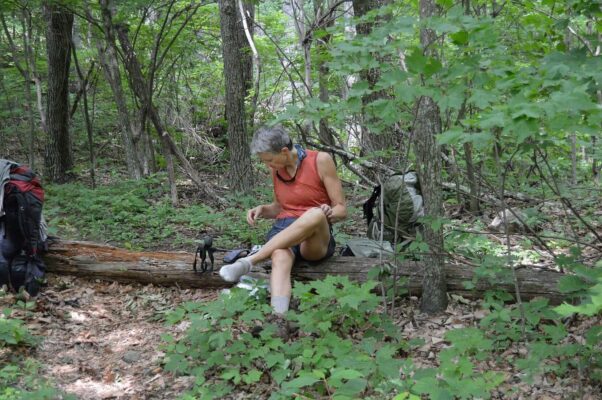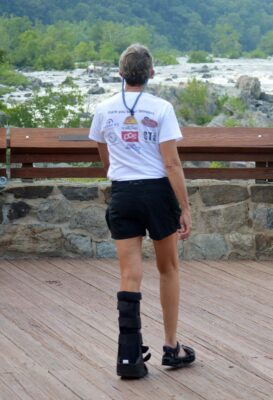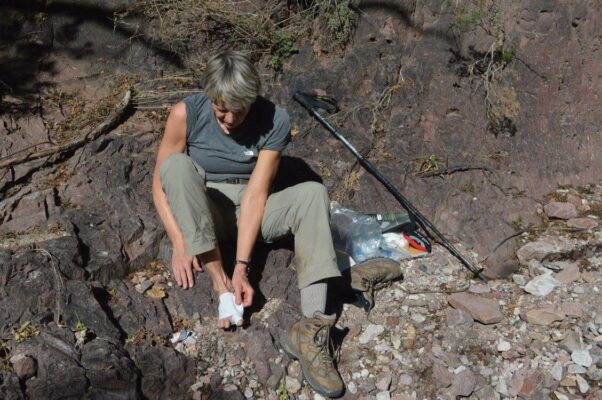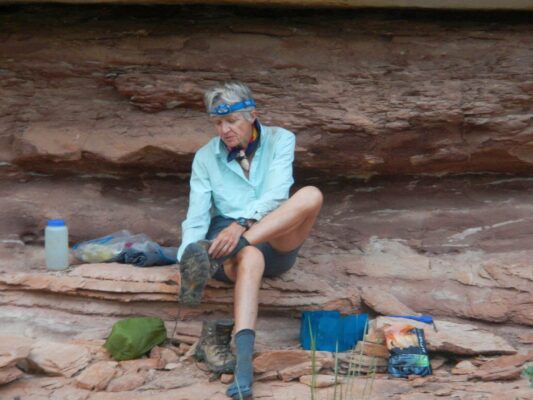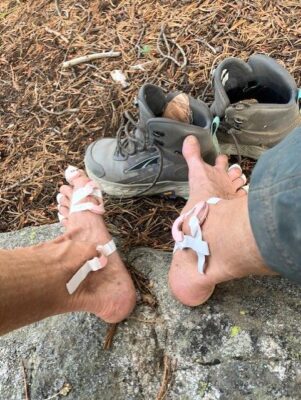(For above slider, click photo & caption will appear below) For more than 50 years, I’ve hiked and jogged on funky flat fleet. I was born with minimal arches and was prescribed “saddle shoes” as a child. Obsessed with long distance runs and rough backpacking trips in college, I often spent morning tent-time padding my toe blisters with moleskin or framing bone spurs (abnormal bone growth) on my heels with callus cushions. With my flat feet and family history of osteoarthritis (breakdown of cartilage in the joints) I was destined for foot trouble.
In my 30s I discovered podiatry and wore inserts to help correct my funky feet. In my 40s I developed “hammer toes”—great toe on each foot turned inwards—and bunions, a big bump on the joint below the great toe. I cut holes in my bike shoes and even wore sandals hiking to reduce bunion pain. In 2008 I tore a tendon in my left foot while training for a half-ironman triathlon; not sure if it ever fully healed.
I finally heeded orthopedic podiatric advice about the toes and bunions in late fall 2010—with surgery on left foot to correct the hammer toe and bunion problem. That went well; bunion was gone, second toe straightened and great toe looked fairly normal.
Of course I was in a rush to get back to my “normal” jogging and hiking life. I insisted on getting the right foot corrected as soon as the surgeon was willing to do it—six months later. David thinks I rushed it as the outcome was not so good. The right toe great turned outward and was supposed to be bound every night. But I could only stand the pain a few hours and would remove the bind. Either I wimped out during a crucial healing time or the toe was just set wrong.
End result: great toe on my right foot turns outwards, often crushing my other toes against the side of a boot. I sometimes have bound my foot to reduce the pain on my pinky toe. I found boots and shoes with a wider toe box, gave up wearing any heels and accepted feeling embarrassed going barefoot at Pilates or yoga classes.
My brother -in-law Dave has opposite problem of mine—high arches—with equal difficulty finding shoes to fit. He suggested Altra trail running shoes—snug through heel and ankle but with wide toe box. They worked for me! I was glad when Altra began offering hiking boots.
In 2024 a pair of Altra Timp Hiker Gore-Tex boots carried me 330 miles in Colorado high country with minimal foot woes and dry feet in the almost daily rainstorms. David had convinced me to buy boots larger than my norm (size 10 instead of size 9.5). Only problem was tripping on rocks with the longer boot!
The Timps continued to support me and keep feet dry on a 2025 California birthday hike with multiple crossings of and near-drowning (!) in the Sisquoc River and facilitated a steep but dry spring loop hike around Mount Wrightson Wilderness in Arizona.
In May we did our normal “northern migration” to Idaho. I thought I brought my backpack, hiking clothes and hiking gear from Arizona. But apparently, I forgot to thoroughly look over my footwear. When we embarked on a 361-mile trek across the Frank Church and Selway-Bitterroot wilderness in Idaho and Montana in July. I just donned the Altra boots I had in the garage.
Hike went okay the first two days. But on the 3rd day it started raining and I realized my boots were not waterproof! A few days later, serious pain from my toes convinced me the boots were too small!
Somehow, I had started the trek with an old pair of non-waterproof Altra boots size 9.5! We don’t have records of where we bought them. I just assumed I had forgotten to bring the size 10 Timp waterproof boots with me from Arizona and unwittingly grabbed the older pair.
A few days later on the Idaho trip, my pinky toes began hurting terribly on steep trail up Raney Ridge near Big Creek. On David’s advice, I removed the “smart feet” inserts I was wearing for more shoe box room. Much later in the trip, my right foot—with the distorted toe that pushes my other toes into far side of boot—finally got so painful on the descent to Tin Cup Lake that I wore a sandal on my right foot to survive the long downhill!
When we got home, I did not find the missing size 10 Altra GTX boots. I called my neighbor in Tucson; a thorough search of my garage did not turn up any missing boots. So, I ordered some new waterproof ones in the larger size. We had one shorter trip ahead in the Wind River Range of Wyoming—I wanted to do it with dry, pain-free feet!
I learned from Recreation Equipment Inc. (REI) that the Altra Timp Hiker was no longer available BUT a new Timp 5 Hiker GTX was available in women’s 10. He thought it was similar. A pair of silver boots arrived a week before our Wind River trek. It was really dry, and I didn’t want to get my new boots dusty, so I foolishly skipped a “check out” hike before we took off for Pinedale August 26.
Trek began in rain showers at Big Sandy Trailhead. Feet were dry for 7-mile trek including mellow trail to Big Sandy Lake, then steep switchbacks and scree scrambling. We camped early at a small meadow, not wanting to climb up a mountain pass in the rain.
I started feeling serious ankle pain about five miles into the second day. The Timp 5 had extra lacing grommets that hurt my ankle bones. We stopped and David padded the area with moleskin and duct tape. That got me through a 13-mile day climbing to Jackass Pass, descent to Lonesome Lake, flat trail down North Fork Creek, long slog over scenic but steep cold windy 11,800-foot Lizard Head Pass and rocky washed out but mellow descent to Valentine Lake on what used to be a well-designed “super trail” with long switchbacks.
Serious pain again the next day dropping to Washakie Creek. More padding and relacing the boots below the offending grommet got me up Washakie Pass. But the top of my left foot was hurting where the unyielding boot rubbed during the descent, so I padded it with gauze.
Finally on the fourth day, I decided pain was similar to bone spurs (which I knew well from my youthful days of foot problems), so I cut callus cushions and arranged them two deep around each ankle and also some framing the top of my left foot.
This provided relief during the next 5 days and 50 miles. But both ankles were still sore and swollen two weeks after the hike!
At home I looked online and learned that “ankle pain with the Altra Timp 5 hiking boots is a common issue caused by stiff seams, pressure from the lacing grommets on the ankle bone, and potentially problematic design where the tongue attaches to the boot’s upper.” Yup.
I am returning the boots. I have no idea what to buy next. Living in the wilds of Idaho, we don’t have access to a good outdoors store. No more online buying. I will start trying on boots when I get back to Arizona which offers many more outdoor retail opportunities. I will not do another backpacking trip without a good long day hike pre-test on the new boots!
And who knows, maybe the beloved blue Timp GTX will turn up somewhere!


